Tackling Complexity – I have outlined this blogpost in 4 stages and want to be clear that this is in no way meant to be linear. I always hate to put numbers or make lists as sometimes it can be interpreted as “I must follow this order”. 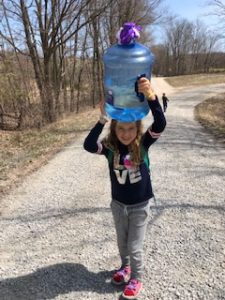
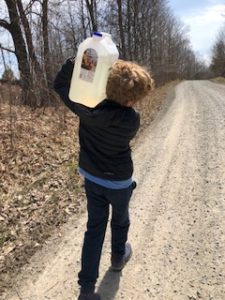 This learning is systemic, circular and non linear, that’s what makes it complex, and that’s what sometimes bogs people down. I hope this helps you facilitate authentic, deep thinking, action oriented learning experiences. Rose and I are leading our own kids, 9 and 10 years old through these kinds of experiences and we have seen the impact it has on them. Students deserve it and the world needs it. I have chunked this into four parts.
This learning is systemic, circular and non linear, that’s what makes it complex, and that’s what sometimes bogs people down. I hope this helps you facilitate authentic, deep thinking, action oriented learning experiences. Rose and I are leading our own kids, 9 and 10 years old through these kinds of experiences and we have seen the impact it has on them. Students deserve it and the world needs it. I have chunked this into four parts.
Where to Begin? – What Process are we going to use? – What tools do we need to work through the process? – How will you know they have learned anything?
It’s a tough message to deliver when a group of passionate students have worked hard on an issue like food waste in school and then all of a sudden the staff room is filled with flies because the rotting apple cores in the well intended food waste bucket haven’t been cleared for days…How can we support students to tackle issues that matter and learn a tremendous amount along the way without getting them down about all the issues?
Whether they are tackling something big or small, local or global, we can support amazing learning and meaningful action in so many ways. When the garbage and dishes left in the cafeteria leads to a campaign of posters, assemblies and more teachers on duty, have we really tackled that issue systemically and deeply? I mean, we just placed our paid educational facilitators of learning (our teachers) as jail guards, I think we could use their time more wisely. The posters were really pretty with comic sans font and nice photos but they didn’t change any behaviour and we killed some trees to do it. How do we avoid unintended consequences when taking action? How can we support meaningful and more well informed actions?
I have witnessed students taking on climate change deeply and after really digging into the surrounding and embedded systems coming up with amazing action plans like changing a schools carbon policy, or two grade sevens pitching ideas to a local hotel about how some upfront investments in window replacement, soap repurposing, and grey water usage could increase their profits and help with their environmental reputation. 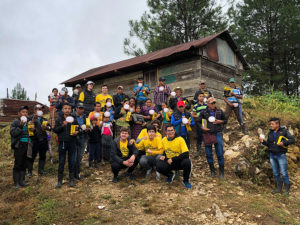 I have seen students walk five hours into a remote village to educate and distribute solar lamps that can allow not only economic savings but educational benefits that can last generations. Some students amazed us with a project to print 3D prosthetics for people who had lost limbs and it gave them an opportunity for employment they never dreamed possible. Students in Singapore worked on an issue of girls not going to school in Cambodia and after digging in systemically found a counter intuitive leverage point of providing private toilets for girls because they learned girls would not come to school because of the lack of privacy. Students can amaze us if we let them!
I have seen students walk five hours into a remote village to educate and distribute solar lamps that can allow not only economic savings but educational benefits that can last generations. Some students amazed us with a project to print 3D prosthetics for people who had lost limbs and it gave them an opportunity for employment they never dreamed possible. Students in Singapore worked on an issue of girls not going to school in Cambodia and after digging in systemically found a counter intuitive leverage point of providing private toilets for girls because they learned girls would not come to school because of the lack of privacy. Students can amaze us if we let them!
It can sometimes be very difficult to navigate a plethora of frameworks, tools, and the deep pool of edujargon that surrounds helping students tackle issues and take meaningful action. Many people check out because it does get very confusing. I hope to try and simplify this complexity for you in one blogpost. I am not saying this is the only method, or these are the only tools, or these are the only organizations and individuals working on this, but I have found in my experience that these work. In my mind, don’t get bogged down by titles, names, organizations, frameworks, tools etc. Simply find a process that works for you and your community and stick with it. Find a common language for understanding these concepts and stick with it. Find a suite of tools that help you move through the process at a level that allows you to find great leverage (action) for a better world. The learning is vast as students learn concepts, competencies and build character throughout the whole process.
Where is your school on the spectrum? It doesn’t matter, start somewhere! There is a spectrum for tackling these big, hairy, wicked, relevant, gnarly issues and I want to assure you that wherever you are, and wherever your school is, that’s just fine, don’t worry, start somewhere. The spectrum goes from…
| Starting Out | Developing (More to Come) | Highly Developed |
| “Our learning program is quite traditional, we have subject areas that we concentrate on that do not connect and are heavily knowledge oriented in our learning program, but we want to try something.” | “We have some opportunities in our learning program as our service learning is well developed, we have personal projects in grades 5 and 9, and great inquiry units in the elementary school“ (These are merely examples) | “We start with great issues of urgency that matter at the heart of our learning program, students own their learning, and we foster great agency in all students by supporting them through the process.” |
Wherever you and your school fall on this spectrum, you can tackle complexity in some way somewhere. The hardest part is just giving it a go.
I am also very fortunate to work with The Common Ground Collaborative who are seeking to co-create schools that are smart, systemic and focus on learning that matters. The starting point for CGC are issues of urgency and building agency in students to tackle them. It also comes with a common language for learning and organizing learning opportunities for students. (3 C’s and 4D’s) By focussing on important concepts, building competencies and helping students grow in character the language resonates and allows for whole communities to be speaking the same language. CGC map – Start With the Urgency and Agency
Whether your school has STEAM. STEM, CAS, Service Learning, Creating Global Citizens, Capstone Projects, Culminating Projects, Project Based Learning, Passion Projects, Innovation Classes, Genius Hour, Units of Inquiry, Personal Projects, Exhibitions, Cross Curricular Units/Projects, or whatever you may call this kind of learning, DON’T LET IT CONFUSE YOU OR YOUR STUDENTS.
At the end of the day it comes down to a very straight forward process, supporting tools, and most importantly, time to actually tackle complexity systemically in order to take truly meaningful action. Think and act systemically! Whatever you want to call it, whatever process or cycle you wish to adopt, whatever tools you use to get there, it’s not complicated.t’s just about simplifying the complexity in deliberate ways.
- Where to begin. (Learning Outcomes, Define and Design the learning) When choosing the complex issue(s) and the learning outcomes there are many ways to engage students. It can stem from curricular learning, something that is going on around your school, city or country (A Pandemic?), and/or ideally something the students care about and are interested in finding out more about. (See my powerful resources section on this website for all kinds of ways to interest students, prompt great questioning and light a spark.) There is no lack of urgent issues to be found locally and globally unfortunately. If you are looking for a ready to go framework then look no further than the Sustainable Development Goals out to 2030.
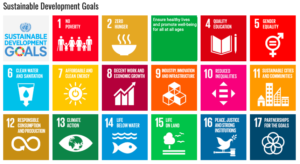 The resources and educational guidance that have been developed for this are endless. You don’t need to re-create the wheel. If you want, start with 60 lessons that empower students to change the world, download the PDF K-12 support here.In an ideal world your curriculum is built around meaningful concepts and issues of urgency. If it is not, then start with a one week off class mini unit or one unit of study, create an elective built to tackle issues, create an inquiry unit starting with a deep concept and or question, there are many entry points. When you start with a rich concept or issue there are many directions it could take. What subject area does this complex issue pertain to? A Global Pandemic. Should it be in science class? Math? Social Studies? English? Arts? PE? Technology? Yes, yes and yes. Don’t let subject walls hold you back. A complexity challenge is an interconnected, intricate, and meaningful issue that students will be seeking to conceptually understand, build competencies to tackle, and grow in character by doing so. Students will not only understand more about how the world works with the intertwining of multiple systems, but ideally will have the chance to create positive change through taking well informed action. The students should have voice and choice for the complexity challenge and the more interest and passion they hold for the issue, the deeper they will go and the more likely they are to take meaningful action. Design Principles for a complexity challenge:
The resources and educational guidance that have been developed for this are endless. You don’t need to re-create the wheel. If you want, start with 60 lessons that empower students to change the world, download the PDF K-12 support here.In an ideal world your curriculum is built around meaningful concepts and issues of urgency. If it is not, then start with a one week off class mini unit or one unit of study, create an elective built to tackle issues, create an inquiry unit starting with a deep concept and or question, there are many entry points. When you start with a rich concept or issue there are many directions it could take. What subject area does this complex issue pertain to? A Global Pandemic. Should it be in science class? Math? Social Studies? English? Arts? PE? Technology? Yes, yes and yes. Don’t let subject walls hold you back. A complexity challenge is an interconnected, intricate, and meaningful issue that students will be seeking to conceptually understand, build competencies to tackle, and grow in character by doing so. Students will not only understand more about how the world works with the intertwining of multiple systems, but ideally will have the chance to create positive change through taking well informed action. The students should have voice and choice for the complexity challenge and the more interest and passion they hold for the issue, the deeper they will go and the more likely they are to take meaningful action. Design Principles for a complexity challenge:
- The challenge has significant substance to tackle because it matters and warrants extended study.
- The challenge is interconnected, has multiple parts and players and requires a systemic approach to understand and take action.
- The challenge should genuinely raise multiple lines of inquiry. (It is capable generating a sufficient number of compelling questions)
- The challenge is tackled from multiple disciplines and perspectives. (You can see it from the balcony and from the dance floor and back again)
- The challenge should be compelling enough to provoke the desire for action. The world is built of interconnecting systems upon interconnecting systems. Jump into the complexity and think deeply–that’s what school is about!
2. What process are you going to use? There are so many great thinkers who have created cycles, processes, flows, or catchy acronyms. Again, just be sure you have chosen a robust process and follow it through. Those who don’t have a clearly articulated process are doomed to miss key stages, depth and systemic understanding. This will lead to a vast array of unintended consequences with students taking action before they even understand what they need to. (Don’t Parachute Cats!)
I will offer what I find works well throughout the post. It does not mean it is the only way. The design cycle, the 5 stages of service learning, PBL pathways, STEAM flows are all wonderfully designed to tackle interconnected complex issues. Pick one for your community and get good at it.
I am fortunate enough to collaborate with a group of dedicated change makers at Compass Education who aim to create a sustainable future through education and action. I love the tools (more later about tools) that we train people how to use and I love to use the Pyramid process to ensure we think through a robust process towards action. The pyramid process can either be done with pyramid lite or a fully constructed pyramid. It essentially takes an individual or group through these steps:
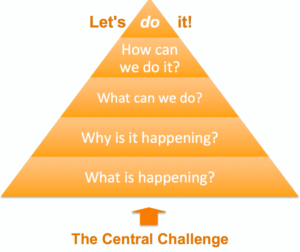
Lets Take Action!
How Can We Do It?
What Can We Do?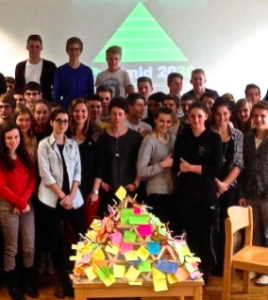
Why Is It Happening?
What Is Happening?
What Is Our Complexity/Issue?
Please do not think that this is a linear process. We do need to have an order but it doesn’t mean you don’t loop back to a previous stage if you need to at any time. A big thank you to Alan AtKisson for providing the tools to Compass Education and the world from his decades of experience in helping groups create the future we wish to see. Pyramid Lite from Alan AtKisson
The Pyramid is one example but IHE’s Solutionary Guidebook and Tara Barton’s Serve Learn Continuum 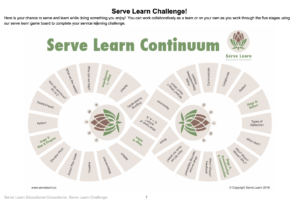 are also sensational along with many others who help guide students through a robust process towards taking meaningful action. I would recommend PICK ONE! OR EVEN BETTER, THERE IS LIKELY ONE ALREADY IN YOUR SCHOOL BEING USED WELL–SCALE IT UP! One thing I can’t express strongly enough is that if your process does not include systemic visualization, mapping and seeking the connectedness of parts of the system it’s likely to lead students to a more shallow understanding of the issue. This, in turn, will likely result in less robust action steps moving forward. That said, we also need to keep students motivated and positive. It’s a fine balance to walk as you want them to deeply understand the issue but you also don’t want them to get down about not “doing anything” about it. Let them pick the low lying fruit of action to keep them going. There’s nothing wrong with simple action steps that create good. These will not create larger, long lasting systemic or mental model shifts, but you do need to keep them motivated. You also have the opportunity to allow them to fail with their actions. It’s great learning to do so. Just be sure you allow time to follow that up with good feedback and then a chance for them to try again..
are also sensational along with many others who help guide students through a robust process towards taking meaningful action. I would recommend PICK ONE! OR EVEN BETTER, THERE IS LIKELY ONE ALREADY IN YOUR SCHOOL BEING USED WELL–SCALE IT UP! One thing I can’t express strongly enough is that if your process does not include systemic visualization, mapping and seeking the connectedness of parts of the system it’s likely to lead students to a more shallow understanding of the issue. This, in turn, will likely result in less robust action steps moving forward. That said, we also need to keep students motivated and positive. It’s a fine balance to walk as you want them to deeply understand the issue but you also don’t want them to get down about not “doing anything” about it. Let them pick the low lying fruit of action to keep them going. There’s nothing wrong with simple action steps that create good. These will not create larger, long lasting systemic or mental model shifts, but you do need to keep them motivated. You also have the opportunity to allow them to fail with their actions. It’s great learning to do so. Just be sure you allow time to follow that up with good feedback and then a chance for them to try again..
3. What tools do you need in the toolbox as you work through the process? The toolbox can sometimes be overwhelming and we don’t know what tool to choose at which time. Sometimes the tool we choose is not robust enough and we rely on the same tool no matter the job. If a plumber came to your house and only brought a wrench, you’d worry. Often in education we rely on certain tools in our assessment toolbox too often. “If the only tool in the toolbox is a hammer, everything starts to look like a nail.” Build a strong cadre of tools to tackle complexity that lead you to fantastic action. How? Get some training online and in person and then try what we know works for us to learn. These are some of my favorites to ensure deep understanding to make informed decisions towards action.
The key to moving towards great action is to take a systemic approach in both your thinking and actions. To begin we need to define what systems thinking is. Systems Thinking – A transformational, interconnected approach to learning, problem solving, and understanding the world. (Waters Center) Systems surround us always and everywhere. Sometimes we lose sight of the interconnected systems that surround us because our instinct is to simplify them by making them linear and sequential. Traditional schooling approaches can be very linear, dividing subjects, time and thinking into straight pathways when really what deep thinkers need to do is to make connections. Whether we are talking about a mechanical system (bike), a natural system (Water cycle), a social system (Government) or an human system (love), they all have parts and relationships between those parts to serve some kind of purpose or end goal. As someone tackling complexity, it is very important to zoom out and visualize those connections and then zoom in on the parts that you want to influence (action). You need to zoom in and out as many times as necessary to find the best leverage points (action). At the end of the day, you can really only change two things. You can either change the system in some way or how people think (mental models). Don’t over complicate it. It was Eric Berlow (Ted Talk) who said, “Simplicity is often just on the other side of complexity”
If you really want to dig deeper into systems contact me and I will recommend books, and/or take a course from Compass Education, Workshops online and in person. Sign up for the Thinking tools studio from the Water Center for Systems Thinking. (Thinking tools studio video found here). The field of systems is deep and fun to dig into, give it a go.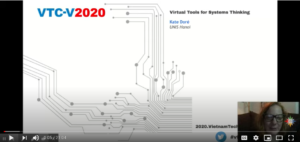 Take a look at the video here from a Compass Educator, Kate on virtual tools for systems thinking.
Take a look at the video here from a Compass Educator, Kate on virtual tools for systems thinking.
So what tools help us through the process? I often get asked what my favorite and most effective tools are, so here goes. We are going to start with what is happening? (From the Pyramid Process) Lets come up with every cause/effect, driver/response we can think of for our issue.
The Compass – My favorite tool to begin with is the Compass. (The organization is named for this tool.) It’s a way to be sure you and your team are thinking about multiple systems conditions as they are related to your complexity or issue. The basic premise is the idea that North, East, South and West (N,E,S,W) are used to help find our way, which is exactly what we are trying to do with our issue. Nature, Economy, Society, and Wellbeing are systems conditions to consider for all issues and the compass helps start to make our wicked problem visual as we try and articulate as many drivers and responses or causes and effects of our issue as possible. 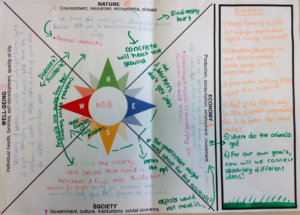 Connections will begin to be made with arrows and and many ah ha moments emerge, along with many deep questions as students consider all angles of the issue. The class can be divided into the different systems conditions or groups can tackle it all together in silence as they paste sticky notes all over the compass. There are so many variations and creative ways to use this systemic tool found on the Compass Website. You can also download the instructions for all the compass tools at Compass Tools .This is a robust, systemic start to our thinking but also remember that it is used to tell us what we don’t know or understand about the issue. There will be obvious gaps, and there will be things we think to be true but need to validate or shatter. Many questions will emerge and the power to generate lots of questions is a super power all kids need. You will often find that the systems condition of Economy (E) comes up with the least amount of information and understanding. I will often direct people to the Ellen MacArthur Foundation. They have done a wonderful job in accelerating towards the circular economy. What is the circular economy? This will be useful both now, in the what and why it is happening stage, and also later when you are thinking of innovations for positive change.
Connections will begin to be made with arrows and and many ah ha moments emerge, along with many deep questions as students consider all angles of the issue. The class can be divided into the different systems conditions or groups can tackle it all together in silence as they paste sticky notes all over the compass. There are so many variations and creative ways to use this systemic tool found on the Compass Website. You can also download the instructions for all the compass tools at Compass Tools .This is a robust, systemic start to our thinking but also remember that it is used to tell us what we don’t know or understand about the issue. There will be obvious gaps, and there will be things we think to be true but need to validate or shatter. Many questions will emerge and the power to generate lots of questions is a super power all kids need. You will often find that the systems condition of Economy (E) comes up with the least amount of information and understanding. I will often direct people to the Ellen MacArthur Foundation. They have done a wonderful job in accelerating towards the circular economy. What is the circular economy? This will be useful both now, in the what and why it is happening stage, and also later when you are thinking of innovations for positive change.
We are still trying to figure out what is happening, try and avoid the urge to find actions, solutions (leverage) yet. Write them down somewhere if ideas come up but we haven’t even figured out what is happening yet, never mind why it’s happening. (systems connections).
Research – The MISO Method –There are so many tools out there for good research that I will only share one as you likely have access to many. It’s not about just Googling! Again, your school should have a common language and approach to research for all ages. The approach should stay the same from K-12. It’s just the level of complexity that increases as they get older. I draw from various global organizations throughout this blog and it’s not to confuse you. It’s simply to show you there are many good options out there. Keep it simple.
The MISO method is simple, comprehensive and accessible for all. The Media, Interview, Survey, and Observation simply gives a framework to dig deeper and build research competencies in students. My 10 year old son is in the middle of a fresh water project and he really enjoyed interviewing experts, gathering observational and historical data and looking for credible sources. The skills he has honed because he has had to communicate, collaborate and organize himself have been outstanding. The MISO framework gave him focus to avoid “lets Google it”. His progress is documented on this very website in his blog if you would like to see an example.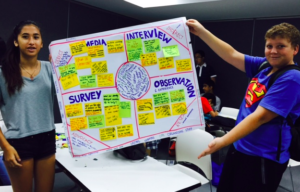
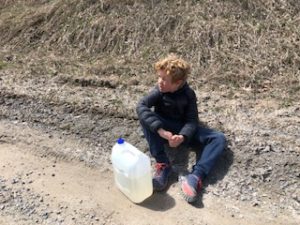 I learned the MISO method from Cathy Berger Kaye and she provides some insight in this blog on her website CBK Associates . Please just ensure that the research approaches are comprehensive, ethical, and guided by deep questions.
I learned the MISO method from Cathy Berger Kaye and she provides some insight in this blog on her website CBK Associates . Please just ensure that the research approaches are comprehensive, ethical, and guided by deep questions.
Systems Mapping and Visualization –The deeper I dig into learning about systems the more I wonder why I never had the opportunity to do so much earlier in life. My own understanding of the connected nature of all things on earth and beyond has developed over time. Some of this learning emerged intuitively, but most has come from a deep dive over the last decade into systems and sustainability. No one was “teaching me” to learn this; I was passionate about creating a sustainable future through education and have come to learn that this would not be possible without a systemic approach. It makes me regret not having been exposed to any deliberate systems literacy earlier in life. Let’s offer these learning opportunities for young people in education to equip them with the tools to affect large-scale change towards some of the biggest and most complex issues facing humankind today.
The systems mapping and visualization tools available are vast. There are many organizations, books, lessons and support of all kinds out there. Again, keep it simple, pick a starting point, and then practice! Take a course from Compass Education and/or The Waters Center for Systems Thinking. Please feel free to contact me for books, next steps, progressions of learning etc.
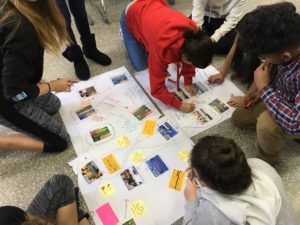 Systems are all around us and visualizing them is the key.
Systems are all around us and visualizing them is the key.
This is where you focus on “Why is it happening”. (From the Pyramid). Our brains cannot hold the level of complexity we are digging into, so we need to make it visible, draw it, use sticky notes, arrows, chart paper, computer software, whatever you have available to make the unseen seen. I will offer a few examples I love to use, but again, there are many. I suggest starting with something like Draw Toast. This Ted talk and method to tackle wicked problems is clear, free and can go as deep as you need to The Draw Toast Website offers an immediate way to visualize any complexity.
As you build a systems vocabulary and get better at visualizing causal connections, your systemic understanding will grow. What influences what? What would happen if this piece of the system changed? What other systems influence this system? There is a vast language surrounding systems mapping but there are a few key principles to understand. A system achieves the outcome it is designed for and when we make alterations there could be many possible outcomes. All we are trying to do is understand the connections and then make predictions based on possible changes. Again, continue to make note of possible actions but it is not yet the time for innovation and action. We are still trying to understand why this is happening. Read this to understand why systems mapping is key to understanding complex problems and build your understanding of balancing and reinforcing loops within systems. Try different mapping techniques as your understanding of the issue grows and you move towards possible innovations (actions) to address the issue. Watch “A Systems Story” for a better understanding of systems concepts.
There is no easy way to explain systems mapping and visualization in a short piece of writing. Seek to understand the concepts behind systems, make them visual, try mapping of various forms. Don’t be afraid of the mess, jump into the complexity and make it visual!
The Systems Iceberg – Look for Leverage in Right Places – As we learn from our systems mapping and visualizations we can see that the connectedness gets complex. As we move towards the “What can we do?” phase of the pyramid, we start to identify possible innovations to get a better result. Don’t be fooled into thinking innovation has to be a shiny new invention or something never before thought of. An innovation simply means you are introducing something to a system where it doesn’t currently exist. A recycling program in your school could be a great innovation, but it certainly isn’t a new idea. It’s just new to your school. This is where the iceberg is so very helpful. It helps to identify the deepest and most effective leverage points. 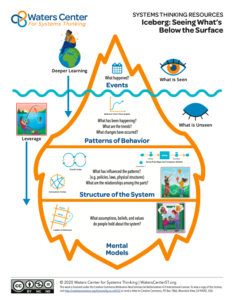 Take a look at The Systems Iceberg explained movie from Systems Innovation. If you are consistently mediating events at the top level of the iceberg, it will not get you to a better place. Look deeper below the surface and make the systems structures and the mental models visible. Your recycling program is likely not going to be effective if all your stakeholders’ mental models don’t support the change. Your new grading system at your school is likely doomed for failure if everyones mental models only know A’s, percentages and GPA’s and have never seen or lived any other alternatives. There are plenty of templates to be found for the iceberg. This Iceberg Template –(from Waters Center for Systems Thinking) is simple and effective. (You will want to sign into the thinking studio for great tools, lessons and templates). You will notice that all the tools interact and intersect with each-other. Systems mapping and mental models (The Ladder of Inference), become visual by using this tool and it is a great process to go from Compass to Iceberg, systems map within, and identify mental models along the way.
Take a look at The Systems Iceberg explained movie from Systems Innovation. If you are consistently mediating events at the top level of the iceberg, it will not get you to a better place. Look deeper below the surface and make the systems structures and the mental models visible. Your recycling program is likely not going to be effective if all your stakeholders’ mental models don’t support the change. Your new grading system at your school is likely doomed for failure if everyones mental models only know A’s, percentages and GPA’s and have never seen or lived any other alternatives. There are plenty of templates to be found for the iceberg. This Iceberg Template –(from Waters Center for Systems Thinking) is simple and effective. (You will want to sign into the thinking studio for great tools, lessons and templates). You will notice that all the tools interact and intersect with each-other. Systems mapping and mental models (The Ladder of Inference), become visual by using this tool and it is a great process to go from Compass to Iceberg, systems map within, and identify mental models along the way.
Ladder of Inference – Mental Models – A mental model is our understanding and our beliefs about the world around us. It is very important to make these visual if we are hoping to create change. Mental models are powerful and can hold people back from change and even lead people to lash out against change. I love to use the Geert Hofstede 6-D model of national culture to help understand mental models from around the world. Please see my powerful resources section here 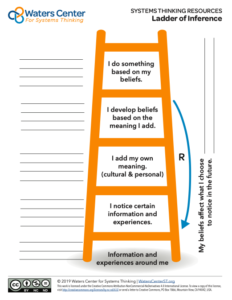 if you’d like to learn more. Now that I am versed in using the Ladder of Inference as a tool for making thinking visual, I am using it all the time in my head to try and figure out why people do the things they do. This Ted Ed – Rethinking Thinking provides a sensational explanation of how the ladder works. It helps us see how all human beings go from observational data all the way to action in seconds, what happens in between in our brain, and why. Remember, if we want to make a change (innovation, action) we can really only change two things: mental models and/or systems. Story Board also shares some good explanations and templates of Ladder of Inference. Compass Education and the Waters Center also have great templates and examples to share.
if you’d like to learn more. Now that I am versed in using the Ladder of Inference as a tool for making thinking visual, I am using it all the time in my head to try and figure out why people do the things they do. This Ted Ed – Rethinking Thinking provides a sensational explanation of how the ladder works. It helps us see how all human beings go from observational data all the way to action in seconds, what happens in between in our brain, and why. Remember, if we want to make a change (innovation, action) we can really only change two things: mental models and/or systems. Story Board also shares some good explanations and templates of Ladder of Inference. Compass Education and the Waters Center also have great templates and examples to share.
Change Theory – What’s Our Strategy? – Now that you have identified possible leverage, innovation, change and action from the previous steps it’s time to ask, “How can we do it?” Let’s create a strategy. You may have come up with the best innovations in the world but without a plan to implement them you may be doomed for a false start, or even worse, you will upset people and possibly even contribute to the problem. I will not get into the plethora of strategic planning tools and templates. I will also not get into the quagmire of change theories and models that exist. Yet again, I will simply suggest picking one that suits your organization, stick with it and get better at it, then refine as necessary. One example that I’ve found useful is the 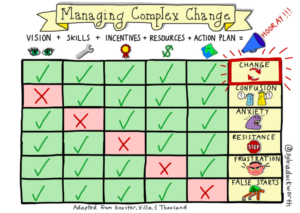 Knoster model for managing complex, systemic change, but there are many more out there.
Knoster model for managing complex, systemic change, but there are many more out there.
I cannot stress enough that students should be using strategic tools and change theory as much as the school board and leadership should be. What an amazing opportunity not to be missed for mentoring and bringing your school community together as a learning organization. Where to start with change theory? I recommend Everett Rogers and the Diffusion of Innovations as he was one of the first to apply social science theory to change and it has been built on since the 1960’s. From his book The Fifth Discipline, Peter Senge goes deeper into systemic complex change in his later book, Dance of Change. Please do contact me if I can help with a more specific recommendation. The framework you choose depends the issue that you are tackling. Crucially, once you understand the system, identify possible leverage and choose the best use of your time to create change, don’t forget to spend time on a detailed strategy. To do so you need to understand change theory. Don’t you wish you had learned that in grade 5?
There are so many tools available for this kind of thinking, mapping, planning and action. I have only scratched the surface here but hopefully enough to allow you to go for it with students in whatever context you can find time to do so. They deserve it–give it a go!
4. How Will You Know They Have Learned Anything? (Demonstration, Assessment) – Of course a key stage in your planning is knowing what the desired learning outcomes are and knowing how you are going to know if the students have actually learned them. Let’s focus on assessment, recording, and reporting as and for learning. When you take on complexity challenges there is no better way to work on student growth in competencies, conceptual understandings and building character. How will you know what they are learning and how will they show you and others? This kind of work lends itself to more performance-based assessment approaches but really there are so many possible ways they can show learning. Ideally, you should let the students come up with ideas of how they will show you and the community what they learned. Build a practical toolkit of strategies that support the notion that all assessment is formative. They can show you through public defenses of learning, learning demonstrations, portfolios, Ted talks, community shark tanks, videos, interviews, self-assessment, peer assessment, and on and on. I will keep this section as brief as possible as assessment is a huge topic, but contact me if I can help in any way.
The learning happens when authentic feedback is provided and then action can be taken on that feedback. For this reason I am a big fan of the single point rubric as it simplifies and targets the feedback. Here is an explanation of what it is from Cult of Pedagogy and 6 reasons you should consider it from Edutopia. There are plenty of examples out there and even sites to help you generate your own. Use rubrics for concepts, competencies and character feedback. No matter where you get your rubrics or if you generate them yourself (I like when students create them), be sure it targets the desired outcomes. If one of the goals was for students to become better collaborators then be sure to provide feedback on them as a collaborator.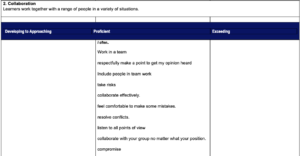 They should also self-assess and have their peers give feedback. If it’s a service learning journey then lean on the experts out there like Servelearn as they have developed wonderful rubrics to help with conceptual learning, competencies and character. I also previously mentioned the Institute for Humane Education for having a process to create solutionaries. They also share rubrics to help give authentic feedback on student action.
They should also self-assess and have their peers give feedback. If it’s a service learning journey then lean on the experts out there like Servelearn as they have developed wonderful rubrics to help with conceptual learning, competencies and character. I also previously mentioned the Institute for Humane Education for having a process to create solutionaries. They also share rubrics to help give authentic feedback on student action.
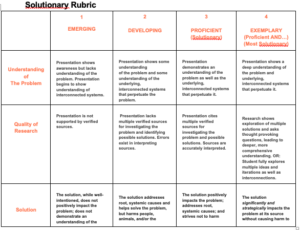
What you are aiming for the students to learn drives your decisions as what to have them demonstrate. I have stressed the need for us to foster systems thinking and systemic practice in students. If you are looking to see if they are getting better at these habits and skills then lean on the Waters Center for Systems Thinking as they have clearly articulated the habits of a systems thinker. You can even dig deeper and use the habits cards that have wonderful questions on the back for reflection and deeper discussion.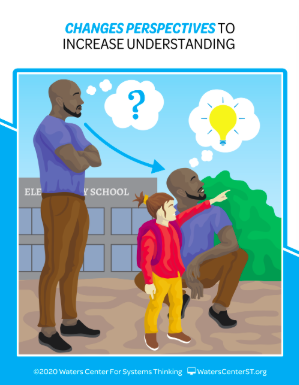
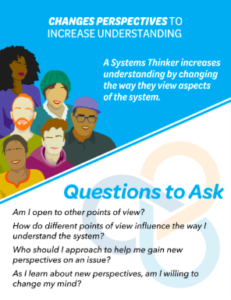
In the thinking tools studio they share example rubrics and planning that have been very well developed to help with peer, self and teacher feedback. This example st-rubric-g6-8 is from an Arizona school district for Middle School but they offer examples for all ages in the Thinking Studio resources. The Waters Center helped develop these resources in conjunction with this school district as it was the original school district to partner and began their work in 1989 together.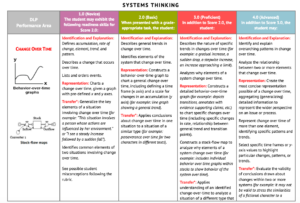
Performance assessment is another one of those education terms that means different things to different people. At the end of the day it is a more authentic way for students to show their understanding and their skill development. I like the way Education Week tackles it in – What is Performance Assessment? Again, no need to reinvent the wheel here as individuals and organizations around the globe have been developing these for years. From the Center for Collaborative Education – 6 performance based assessment examples for all ages. Performance Assessment tools and resources from Envision Learning Partners. Also take a look at the defense of learning and portfolio defense. You can also explore the Performance assessment resource bank. from the Stanford Center for Assessment.
As we transition to focussing on competencies in schools because we know it is key for students emerging into a future that is unknown there is no better organization to lean on than GOA. The Global Online Academy has developed a Competency based toolkit that is a great resource to help educators and schools make five essential shifts necessary for competency-based learning:
- From content-driven to skills-driven
- From time-based to performance-based
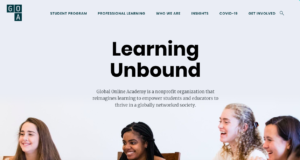 From lessons to experiences
From lessons to experiences- From grading to feedback
- From teacher-designed to co-designed
GOA not only offers a great toolkit but are leaders in online learning, PD and Authentic learning for students.
Demonstration needs to be in service of the learning process so keep it focussed on assessment as and for learning. If they are involved in a big culminating event for their complexity challenge and the learning ends there with no feedback or chances to make changes then we have missed an opportunity for deeper learning. Provide opportunities for formative assessment all along the way. Let me know if I can help in the development or sourcing of assessment formats that support learning that matters.
Now What?
Start Somewhere – Stick to a Process – Fill the Toolbox – Use Assessment As and For Learning – Reflect – Reflect – Reflect – Try Again – Repeat (Not in a linear fashion)
I hope this is helpful to you and look forward to seeing more and more students around the world engaged in deep, authentic, world changing learning.
Educating towards a more positive future means facilitating learning that is connected to our global reality in a way that is engaging, thought-provoking, character-developing, and skill-building. Ultimately schools around the world would be fostering global citizens that not only embrace the complexities, but also have the will and skills to create sustainable solutions for a better world. A systemic approach is the key to both deeper learning and embracing complexity for better solutions to today’s most difficult issues. A systemic, connected approach will help prepare students for a future that is unknown and ever changing. The traditional factory model of kindergarten to grade twelve (K-12) education is not serving the learning needs of a new generation of complexity thinkers and practitioners. It is systemic thinking and practices that will not only transform learning experiences for students but also lead to identifying leverage points of change from within and around the K-12 education system itself.
As a school leader from within the system and as an external consultant to many schools globally, I have been fortunate to work with dedicated, caring teachers, leaders, board members and parents. The desire to set students up for success in their future, open doors, and give them the competencies to follow their passions exists the world over. What is now required is support internally and externally to systemically transform antiquated practices and remove the barriers to deep, connected, meaningful learning for all ages. I hold great hope that this is not only possible on a large scale but it can happen faster than we may believe. I believe this is true because of the countless examples I have witnessed of educators finding leverage in their day-to-day practice and the growing number of new school models being created around the world. Our children need it, they deserve it, and our future depends upon it.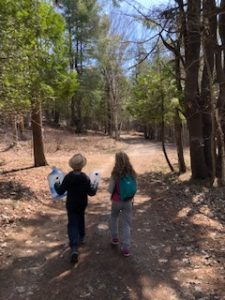

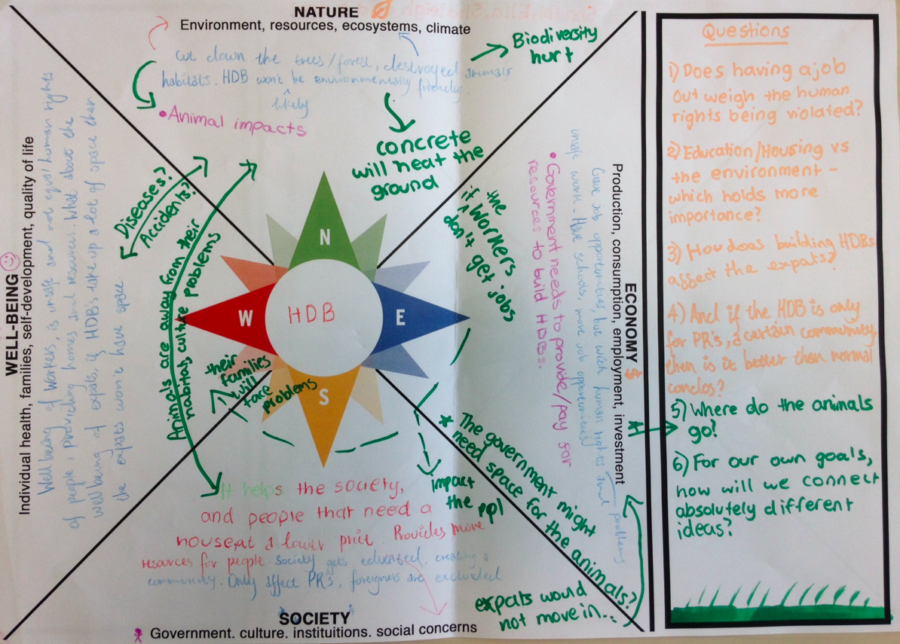
Please comment on the blog and let me know what you would change, add, amend, take away. Also please let me know how you have been or will use it. I already received 2 tweets saying this will help them plan their fall courses.
Thanks for reading and doing what you do.
Mike
Thank you for your time and thought you put into this post. Thinking beyond students and schools, people in general, sometimes in very powerful positions, forget to look at the complexity of issues and seek quick fixes that actually are not sustainable or may have negative impact on the system. I appreciate that you included so many links in here, some familiar, some new to me. Your post came at a perfect time.
Thank you Terje,
So happy you find it useful and would love to see what you are planning on doing with students. What an amazing generation of thinkers and doers we could raise! Let me know if I can support.
Mike
I would say this is one of the best article I’ve read.
From beginning to end you nailed it totally.
To write this you might have worked for research.
Best regards,
Harrell Raahauge
I thank you very much for the kind words and hope it can help kids get the authentic, personalized and action oriented learning they deserve. Let me know if I can support in any way.
Mike
Like!! I blog quite often and I genuinely thank you for your information. The article has truly peaked my interest.
Thank you for your comment. I hope it is useful.
Mike